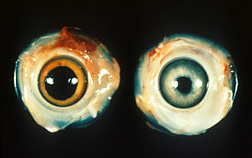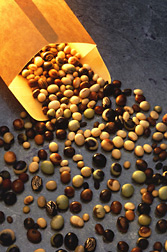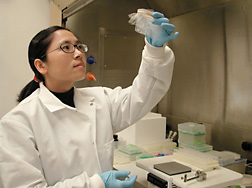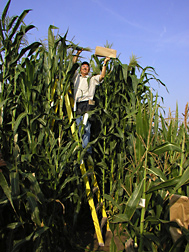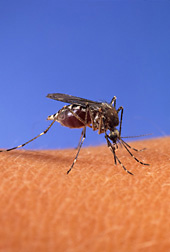Partnering With Industry Pays Off
|
|
“ARS is an agency that is profoundly good at partnering,” says ARS Office of Technology Transfer (OTT) assistant administrator Richard J. Brenner.
Brenner offers up the following numbers as proof: In 2008, ARS participated in 230 active cooperative research and development agreements (CRADAs) with external partners, including universities and private industry. In the same year, ARS partnered in 5,466 other collaborative agreements and contributed research that led to 116 new invention disclosures and 29 issued patents.
OTT representatives routinely attend trade shows and provide prospective industry partners with information on the advantages of working with ARS scientists.
The staff also develops strategic partnerships with outside organizations and pursues patents and licensing that facilitates technology transfer to the marketplace.
In September 2007, OTT closed the deal on its first partnership intermediary agreement (PIA). The inaugural agreement was signed with the Maryland Technology Development Corporation to focus on technology-based business development that will boost the economic sustainability of privately held companies in Maryland. PIAs are another way that ARS can establish agreements with nonprofit organizations that then serve as intermediaries to assist ARS with its technology transfer. A second PIA was signed with the Mississippi Technology Alliance in December 2008.
“Partnering brings research dollars to the bench and increases the likelihood of rapid adoption by the private sector,” Brenner says. “Our role at OTT is to facilitate and nurture these external partnerships for our scientists. The bottom line is that a CRADA lasts for up to 5 years—but a good research partnership and its impact will go on for much longer.”
|
|
Private Partnering Premieres
In 1987, the ARS Avian Disease and Oncology Laboratory (ADOL) in East Lansing, Michigan, was the first government lab to sign a CRADA with a private company. That CRADA was with Embrex, Inc., now part of the Pfizer Poultry Health Division in Durham, North Carolina. It was for an in-the-shell vaccination technique against Marek’s disease. Since then, ARS has had six more CRADAs with Embrex to develop the same technique for avian coccidiosis, salmonella, and other viral diseases.
Through industry grants, the East Lansing lab is currently working with the following companies to protect poultry against viral diseases: Aviagen (Huntsville, Alabama), Cobb-Vantress, Inc. (Siloam Springs, Arkansas), Hy-Line International (Des Moines, Iowa), and Hendrix Genetics (The Netherlands).
The lab began in 1939 to respond to an epidemic of avian leukosis. In 1977, in concert with industry, ARS developed a quick test for the disease, putting industry on a secure path until a more virulent form appeared in 1989.
In response, ARS immediately redirected its research to address this threat, working with industry to bring the new strain under control with another quick test and an eradication program.
“This lab continues its historical role as a leader in poultry tumor research, namely on Marek’s disease, avian leukosis, and reticuloendotheliosis. Without ARS, control of viral tumors wouldn’t be what it is today,” says ADOL research leader and veterinary medical officer Aly Fadly.
The lab is always trying to keep ahead of viruses that are constantly evolving into more virulent forms that evade current controls. ADOL continues to work with private and public researchers around the world through grants and other agreements.
|
|
Field Crop Fellowship
Only two races of maize were used to develop the Corn Belt Dent variety of field corn grown by U.S. producers. These two races contained less than 1 percent of the genetic characteristics found in maize varieties worldwide.
The Germplasm Enhancement of Maize (GEM) Project is an ARS-led partnership of public and private organizations that encourages scientists and breeders to explore the remaining 99-plus percent of maize genetic diversity. The goal is to adapt exotic maize races for U.S. production and develop new lines that can be used by U.S. maize-breeding programs.
Mike Blanco, an ARS geneticist who works at the North Central Regional Plant Introduction Station in Ames, Iowa, is in charge of managing GEM.
“There are between 250 and 300 maize races in total,” Blanco observes. “We are coordinating a multisite cooperative program for germplasm evaluation, development, and information sharing. We want to find traits that can improve maize yield and stress resistance and enhance other value-added characteristics.”
|
|
More than 60 collaborators in private industry, universities, and other groups around the world currently contribute to GEM activities, which to date have resulted in the release of 202 maize lines. These lines, used in public and private research and breeding programs, were developed from 24 races collected in 14 countries.
Some of the released germplasm has provided new genetic sources of resistance to excessive heat, drought, and other environmental stresses. Other lines are resistant to insect pests and mycotoxins. Varieties have also been developed with improved protein, oil, and starch content and traits that could enhance ethanol production.
Should a new threat—like an invasive insect or emerging disease—appear, these diverse maize lines might also contain a reservoir of resistance traits that current commercial varieties, with their narrow genetic base, do not possess.
“GEM is off to a great start,” says Blanco. “Now we’d like to find new ways to breed exotic maize germplasm and identify favorable traits. We also want to develop new lines from GEM germplasm to explore how genetic diversity and its structure affect trait expression.”
|
|
Shared Stakes for Soybean Partners
The St. Louis, Missouri-based United Soybean Board (USB) consists of 68 farmer-directors who oversee investments of the soybean checkoff fund on behalf of all U.S. soybean farmers.
ARS and USB have a long, fruitful history of collaboration aimed at furnishing America’s growers with the best varieties that science and plant breeding have to offer. “This collaboration with USB allows us to pool resources in areas of common interest—with economic and other benefits to multiple industries and consumer groups,” says Roy Scott, ARS national program leader for crop production and protection.
Many ARS- and USB-funded projects involve multiple ARS laboratories and cooperators. One long-term project involves seed composition—oil improvement for human consumption and protein-meal improvement for animal consumption. Led by Joseph W. Burton at the ARS Soybean and Nitrogen Fixation Research Laboratory in Raleigh, North Carolina, project researchers have developed new information about the genetics of oil and protein-meal traits, discovered DNA markers associated with these traits, and made several breeding lines available to other soybean breeders in both public and private industry.
From another long-term project, five slow-wilting soybean breeding lines were developed that yield 4 to 6 bushels more than conventional varieties under various drought conditions. These new breeding lines are being used in commercial breeding as parent material. Thomas Carter, also with the Raleigh laboratory, leads the project.
|
|
On the industrial front, a Peoria, Illinois-based ARS project led to a soy-flour-based glue that’s been used since late 2001 in wood composites—a contribution to green construction materials.
Recent projects include efforts to:
• create a library to genetically characterize more than 19,000 soybean accessions in the USDA Soybean Germplasm Collection using DNA markers known as “single nucleotide polymorphisms” (SNPs). Each accession’s 50,000 SNP markers will provide soybean researchers and plant breeders with a valuable resource for improving soybeans. David L. Hyten and Perry B. Cregan at ARS’s Soybean Genomics and Improvement Laboratory (SGIL) in Beltsville, Maryland, are coordinating the multilocation project.
• test low-phytate soybean meal that, when fed to farm-raised rainbow trout, will reduce the fish’s excretion of phosphorous pollutants in water—from hatch to harvest. Frederic T. Barrows leads the project at ARS’s Hagerman Fish Culture Experiment Station in Hagerman, Idaho.
• genetically engineer soybeans for resistance to soybean cyst nematodes. In preliminary tests by Benjamin Matthews at SGIL, 80 to 90 percent of juvenile female nematodes that fed on roots of the resistant soybeans died or failed to mature by 30 days.
Ganging Up Against Insect Pests
Scientists at the ARS Center for Medical, Agricultural, and Veterinary Entomology’s Mosquito and Fly Research Unit in Gainesville, Florida, are evaluating compounds from a large chemical library to identify active ingredients that demonstrate efficacy for killing mosquitoes and other disease carriers.
Led by entomologist James Becnel and research associate Julia Pridgeon, the team uses high-throughput systems to screen large numbers of compounds for toxicity to mosquitoes. This research is conducted under a CRADA with a chemical company.
“High-throughput systems allow us to use a combination of bioassays with mosquito larvae, data processing, and structural analyses to quickly screen and test each chemical’s potential as an insecticide,” says Becnel.
Different bioassay methods are used to test various activities of candidate insecticides. After being tested against immature mosquitoes, the pesticides are tested against adult mosquitoes to select new active ingredients that might be registered and used for their control.
“In our laboratory tests, several compounds have already been found to be more toxic to mosquitoes than currently registered insecticide products,” says research leader Gary Clark. “We have conducted tests with many different compounds in an effort to determine which might best be developed by chemical companies and meet the needs of our mosquito-control stakeholders.”
The search for new, environmentally friendly insecticides for public health use is being done in partnership with the military as well as industry. The Deployed War-Fighter Protection Research Program has provided funds and promoted industry collaborations and partnerships to advance this important initiative.
This U.S. Department of Defense program has just begun its second 5-year funding period, which has encouraged several ARS laboratories to apply their scientific skills to the practical problem of protecting U.S. military personnel in the field from vector-borne diseases.—By Ann Perry, Rosalie Marion Bliss, Don Comis, Sharon Durham, and Jan Suszkiw, Agricultural Research Service Information Staff.
This research is part of Animal Health (#103), Plant Genetic Resources, Genomics, and Genetic Improvement (#301), Plant Biological and Molecular Processes (#302), Aquaculture (#106), Plant Diseases (#303), and Veterinary, Medical, and Urban Entomology (#104), six ARS national programs described on the World Wide Web at www.nps.ars.usda.gov.
To reach scientists mentioned in this article, contact Ann Perry, USDA-ARS Information Staff, 5601 Sunnyside Ave., Beltsville, MD 20705-5129; phone (301) 504-1628, fax (301) 504-1486.
"Partnering With Industry Pays Off" was published in the March 2009 issue of Agricultural Research magazine.







